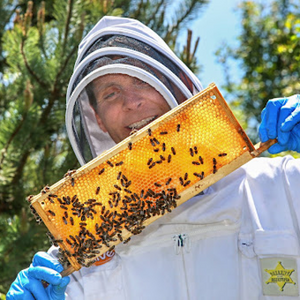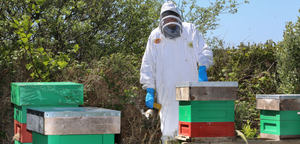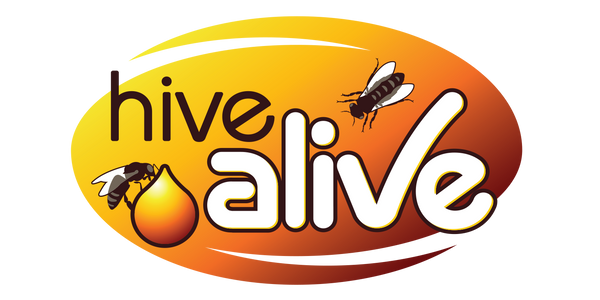
Our Story
How did the creator of the world-leading feed supplement for bees, HiveAlive, get to where he is today?
Dara Scott’s passion for all things honeybee related began with a trip to New Zealand over 20 years ago. The physics graduate, who had been working in medical diagnostics, took a year out to explore New Zealand and became fascinated by the amount of beekeeping that was going on there.
"Everywhere I went I could see beehives”, he says of his New Zealand experience. In Ireland, where Dara is from, all the hives are hidden behind stone walls. Reading up on beekeeping, he loved the idea of the symbiosis of the beekeeper helping the bees and the bees returning the favour with honey. Upon returning, he prepared for getting his own hives. He began with a small cast swarm captured near his home that a beekeeper collected for him. The apiary expanded and grew from there, but so too did his frustration with the lack of natural methods to keep the honeybees healthy.
“I wanted to keep my bees as healthy as possible so that they could fight off diseases and stresses and also be more productive and survive better. The west of Ireland is definitely not the easiest place to keep bees!” says Dara. “It is one of the windiest and wettest places in the world, rarely having temperatures above 20°C/68°F. Bees can survive the cold and the heat but rain and wind are not their friends.”
Still, Dara manages to get a reasonable honey return every year and builds nucs for beekeepers in the spring. He is keen on promoting Ireland’s native honey bee Apis mellifera mellifera (Amm).
This bee was once spread across the whole of Europe, but studies have shown that Ireland may have the last significant, stable population of Amm, because in the few other places where it does still survive in Europe, its genetics have been severely compromised by introgression from other strains. By keeping the nucs over the winter, Dara can get them to new beekeepers early in spring when they are looking for them. “By providing these beekeepers with an option to obtain native bees early in the spring they are less likely to import different sub species from the continent which additionally can carry diseases not yet prevalent in Ireland”, says Dara.
Ireland has a long history of beekeeping, despite the inclement weather. Over 1600 years ago beekeeping was so important to Gaelic Ireland that there was a complete list of laws dedicated to beekeeping. The bee laws, called the “Bechbreatha” were the most important of all the Brehon Laws relating to land and agriculture at the time. Over twenty pages were dedicated to bees and beekeeping; covering swarms, hives, honey production and so on. One law in particular shows how high a value was placed on bees. If a person who was stung by a bee had not retaliated by killing the bee they would be entitled to a meal of honey from the beekeeper. If, however, the person died from the sting then two hives were paid in compensation to their family!

Dara has a degree in physics and spent many years working in R & D for medical device companies. After his visit to New Zealand, Dara landed a dream job with the Woods Hole Oceanographic Institution, USA. He spent almost a decade exploring the planet’s deepest oceans with one of the world’s deepest underwater vehicles, a robot called Jason, which could travel to depths of over 4 miles. Dara had the opportunity to explore multiple exotic locations such as the Pacific islands, Easter Island and the Aleutian Islands in Alaska. On his travels around the world Dara met with many beekeepers and learnt the many ways people keep bees. From Carniolans to Russian mite resistant bees, Italians to Apis mellifera jemenitica in the Middle East, Dara has seen a lot of bees!
